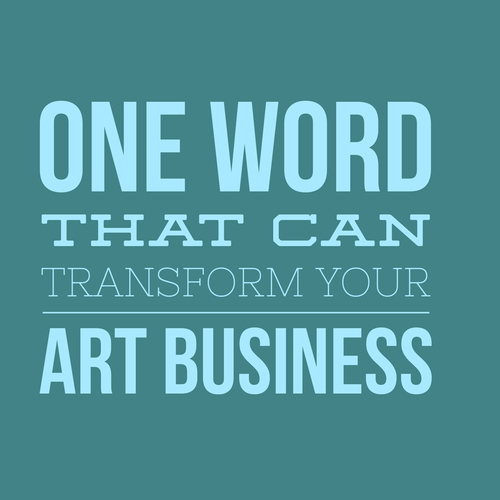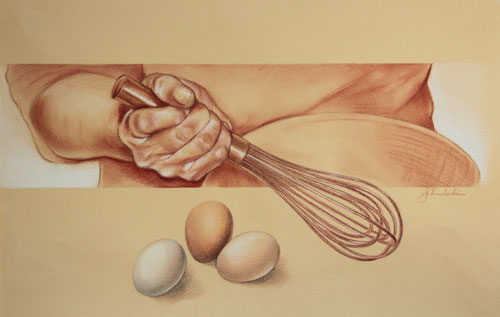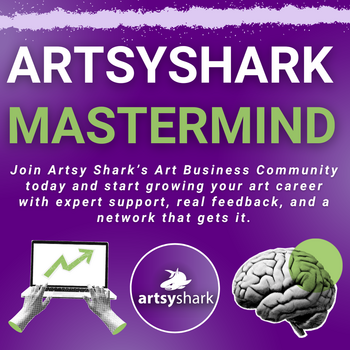by Carolyn Edlund
Bill Gates and Warren Buffett were asked to write down the one thing they attributed the most toward their success. They both answered with the same word: Focus.

The word “focus” resonates strongly with me, as someone who works with artists on their businesses and on strategies for growth. It’s an essential part of structuring a creative business. Focus is needed from the very beginning – starting with the body of work itself.
One of the weaknesses I see quite frequently, especially with beginning artists but also sometimes with very experienced ones, is a lack of focus in their portfolios. They may use different mediums, practice various techniques, and offer images of a variety of things – perhaps landscapes, portraits, still lifes, abstracts and more. I have heard artists claim that they are versatile, and want to show breadth. Personally, I would rather see depth.
An example of an artist with a highly focused portfolio is Joan Chamberlain. Her work is focused on hands – specifically, the hands of people who work in the kitchen, laboring to create and serve the food and beverages we consume. Her concept is fascinating. She faithfully fleshes out her series in charcoal and colored pencil in a signature style that builds on her concept and is tightly cohesive.

“Whisk Until Foamy” Charcoal and Colored Pencil on Paper, 19″ x 13″ by Joan Chamberlain
When focus is lacking
Lack of focus can leave your audience wondering, “What is it that they really do?” or “Is this a hobby?” It can put you in a position of being instantly forgettable. There are many, many artists out there who are “generalists” who fail to get traction. Supercharge your portfolio with focus and see what happens.
Another problem that can occur is a lack of focus in choosing a market for your artwork. I’ve heard plans like, “I want to sell my work through galleries, and license my art, and also sell directly to collectors through my online website.” My response is often, “Pick one, and start there.” Going in too many directions at once can result in watered-down efforts, and a portfolio that is not presented properly for your audience. Ultimately, exhaustion sets in when you are trying to get everything done. You either get discouraged or give up entirely.
Staying on task
Many artists have multiple streams of income. That doesn’t mean you have to attack every market at once. If you are passionate about being licensed, research the field first. Get to know how the business works and the needs of the clients. Learn how to prepare your portfolio presentation for that market. Then, follow the road map you have created by focusing your efforts and attention to reach your goals.
Focus also applies to the tasks we do every day in business. Everyone has strengths and weaknesses. Assign yourself the tasks that you do best, and get assistance where you need help. Your most important work is in the studio. I’ve spoken with artists who are trying to learn to build a website, who spend hours packing and shipping, or are doing their own taxes. They find it hard to delegate anything. This results in wasted hours performing tasks far below their abilities, or that doesn’t reflect their expertise.
Every time you apply a strong and consistent focus to a part of your business, you accomplish more. It’s easy to get distracted or fail to prioritize. This often occurs simply because you fail to notice that you are getting off track. Bring the vision you have for your business and your goals back into focus and move forward.
Have you experienced a change in your own art business because you gained focus? What happened?



Words of wisdom, however, I am totally frozen to decide which nature art to focus on, as my birds, landscapes, and flower paintings have sold almost equally in the last two years. On top of it all, I have an even number of sales of acrylics vs. watercolors…what would you suggest I do?
Helena, My suggestion for you is that if you are presenting your art in the press, or in a marketing format (such as a lookbook) or if you are selecting work for an exhibition, choose pieces that are in a series or work as a grouping. This will give the strongest presentation. And, look at your entire portfolio with a critical eye, and remove any work that isn’t quite up to par. You will be judged on the weakest piece you show.
Great article! I needed this reminder today… staying focused can be difficult sometimes. 🙂
A fine article! I find the more I paint, the more focused I become and the more my style emerges. My biggest distraction? All of the “other”- with my business background I am comfortable with the concept of sales and marketing but the modern world of analytics and websites, social media and memes? It’s so so hardto try to keep up when there are only 24 hours in the day? Is there a checklist out there? Website? check. Instagram feed? check. Newsetter? check. that kind of thing… Google analytics might has well be Chinese or Russian. I just don’t what I am reviewing!
I’ve always had problems with this advice. I see painting the same thing over and over as kind of boring, and show a lack of talent and imagination. As if you can only paint one thing and that’s it? It seems so limiting to me. I do landscapes, still life and some animals. I will try to keep my submissions to the same genre but I need to paint what inspires me and that’s light and shadow and realistic details, no matter the genre, the subject to me is the mood, details and chiaroscuro. Does that make sense?
Denice, It sounds as if the continuity in your work is the mood, details and chiaroscuro technique. A cohesive portfolio doesn’t always mean painting the same subject matter. It doesn’t always mean using the same medium. A distinctive signature style can certainly transcend those, with a recognizable “voice” that brings the portfolio together.
I’ve seen many, many portfolios by artists of all types, and would define an unfocused presentation as one that has a “bit of this and bit of that” – different mediums and styles that are jumbled and make no sense or impact as a group.
Over time, it is natural that your work evolves. Sometimes artists work in a distinctive series that is highly focused, and later they may take up another subject matter or interest. That isn’t a bad thing. As you mentioned, you could group your presentation into collections, and present that collection as a submission. Lack of focus has more to do with not going deeply into any style or subject and not having a grouping of art that works together.